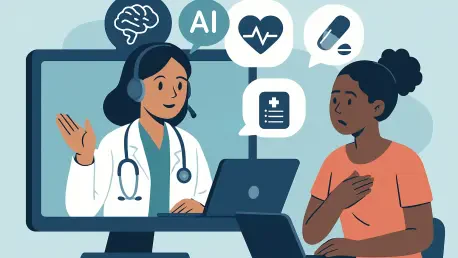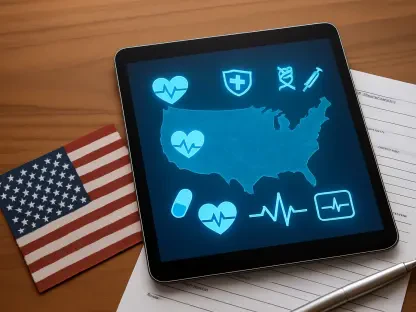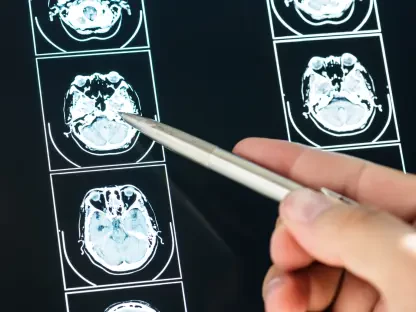Imagine a healthcare system where providers are freed from the crushing weight of administrative tasks, where technology anticipates needs before they become crises, and where patient care remains deeply human despite digital advancements. This vision is no longer a distant dream but a tangible goal, as highlighted at the recent HIMSS AI Leadership Strategy Summit in Chicago. This pivotal event brought together industry leaders, clinicians, and technology experts to explore how artificial intelligence (AI) can transform healthcare delivery. Amid rising costs, staffing shortages, and provider burnout, the summit positioned AI as a potential ally rather than a threat, emphasizing strategies to support healthcare workers without replacing them.
Key Takeaways from the Chicago Summit
The HIMSS AI Leadership Strategy Summit served as a critical platform for discussing the integration of AI into healthcare, a field often cautious about adopting new technologies. Attendees grappled with pressing challenges facing the industry, from overworked staff to escalating expenses, seeking solutions that prioritize both efficiency and empathy. The central focus was on fostering trust and collaboration between AI systems and healthcare professionals, ensuring that technology enhances rather than undermines the human touch in medicine.
Beyond the overarching themes, the summit offered a deep dive into actionable approaches for AI adoption. Experts shared insights on designing tools that complement clinical expertise, tailoring implementations to specific needs, and measuring success through qualitative as well as quantitative metrics. These discussions underscored a collective commitment to reimagining healthcare workflows, with AI positioned as a supportive partner in addressing systemic pressures.
Building Confidence in AI Tools
A recurring concern at the summit was the perception of AI as an opaque system, often described by clinicians as a “black box.” Dr. Everett Weiss of Rochester Regional Health emphasized that this lack of transparency breeds distrust, particularly when outputs could influence patient outcomes. To bridge this gap, speakers advocated for clear explanations of how AI reaches its conclusions, ensuring users understand its limitations and capabilities.
Addressing this skepticism requires rigorous validation before deployment, as highlighted by several panelists. Educating healthcare workers on AI functionalities was deemed essential, alongside maintaining human oversight in decision-making processes. Susan Fenton from the University of Texas Health Science Center at Houston pointed out that AI lacks independent licensure, reinforcing the necessity of a “human in the loop” to uphold accountability and safeguard patient care.
The dialogue also touched on the ethical dimensions of AI use, with experts stressing that trust is not just technical but relational. Building confidence involves not only refining algorithms but also fostering open communication between developers and end-users. This dual approach aims to demystify AI, making it a reliable tool in the hands of clinicians rather than an enigmatic force.
AI as a Partner to Clinicians
One of the summit’s key revelations was the potential for AI to take on data-intensive tasks, allowing healthcare providers to focus on what they do best—caring for patients. Sagar Parikh of Ensemble Health Partners noted that AI excels at analyzing vast electronic health records to support processes like claim denials, a task that often overwhelms staff. This capability frees up time for clinicians to engage more meaningfully with patients.
Beyond data management, AI was showcased as a remedy for administrative burdens that contribute to burnout. Documentation, a notorious time sink, emerged as a prime area for AI intervention. Fenton shared findings from a pilot at UT Health Houston, revealing that while AI documentation assistants saved only a modest amount of time—about nine minutes daily—the boost in provider and patient satisfaction was significant, warranting further exploration.
This complementary dynamic ensures that AI does not encroach on the nuanced, contextual judgment that clinicians bring to their work. The summit discussions reinforced that human expertise remains irreplaceable in interpreting subtle cues and prioritizing critical information. By handling repetitive chores, AI can help restore balance, enabling healthcare workers to rediscover the fulfillment of their roles.
Customized AI Adoption Strategies
Recognizing that not every clinician benefits equally from AI tools, the summit featured interactive workshops to explore personalized implementation. Dr. Weiss shared an example from his system, where a note-taking assistant was widely appreciated by most providers but left some unimpressed due to minimal efficiency gains. This variability underscored the need for flexibility in how AI is introduced and applied.
These sessions also highlighted a broader aspiration—to bring back the “joy of medicine” for providers burdened by routine tasks. Participants engaged in group activities to brainstorm how AI could be adapted to diverse clinical settings, ensuring it serves as a supportive aid rather than a rigid mandate. The emphasis was on listening to user feedback to refine tools for maximum relevance and impact.
Tailored adoption emerged as a cornerstone of effective integration, with attendees advocating for pilot programs that test AI in specific contexts before scaling up. This approach minimizes disruption while allowing organizations to identify which applications resonate most with their teams. The collaborative spirit of these discussions reflected a shared determination to make technology a true enabler in healthcare.
Demonstrating AI’s Practical Impact
The summit also featured exhibitions of proven AI applications, offering concrete examples of technology already making a difference. Radiology triage systems stood out as a success story, efficiently prioritizing cases for review while maintaining clinician oversight. These demonstrations provided a roadmap for organizations hesitant to dive into uncharted AI territory.
Speakers encouraged healthcare systems to start with established solutions or replicate successful projects from peers, reducing the risks associated with innovation. Unlike initiatives driven solely by financial motives, the showcased tools prioritized enhancing patient care and supporting clinical workflows. This focus resonated with attendees seeking practical entry points into AI adoption.
The hands-on nature of these presentations allowed participants to witness firsthand how AI can integrate seamlessly into daily operations. From streamlining diagnostics to improving resource allocation, the applications on display illustrated a future where technology and human expertise coexist harmoniously. Such real-world examples served as powerful motivators for cautious adopters.
Envisioning AI’s Long-Term Role in Healthcare
Reflecting on the summit’s insights, a clear narrative took shape: AI holds immense promise for tackling healthcare’s systemic challenges, provided it is implemented with transparency and trust at the forefront. The event emphasized that success lies in strategic integration, where technology amplifies clinician capabilities without overshadowing their judgment. This balance is critical to ensuring that patient outcomes and provider well-being remain the ultimate priorities.
The discussions also pointed toward a shift in how AI initiatives are evaluated, with a call for metrics that capture satisfaction and experience alongside efficiency. This holistic perspective, championed by experts like Fenton, suggests that the value of AI extends beyond mere numbers to the quality of interactions it enables. Such an approach aligns with broader industry trends favoring technology that supports rather than dictates care delivery.
In wrapping up the event coverage, the HIMSS Summit in Chicago proved to be a turning point in framing AI as a collaborative force in healthcare. Moving forward, the industry was urged to invest in education and testing to build trust in AI systems, customize tools to meet diverse needs, and adopt proven solutions as stepping stones. By fostering partnerships between technology and human providers over the coming years, such as from 2025 to 2027, healthcare systems can address immediate pressures while laying the groundwork for sustainable innovation.









